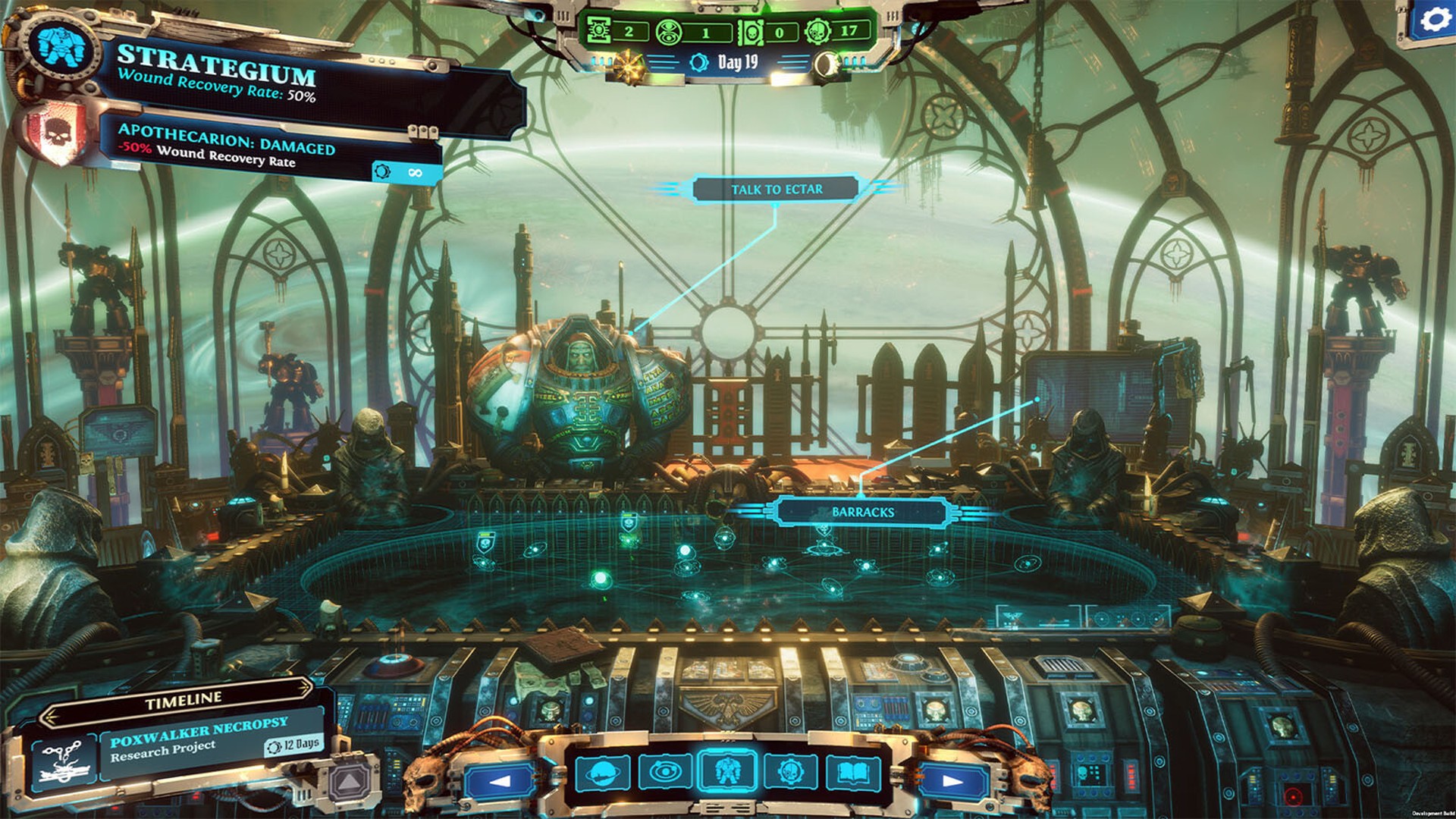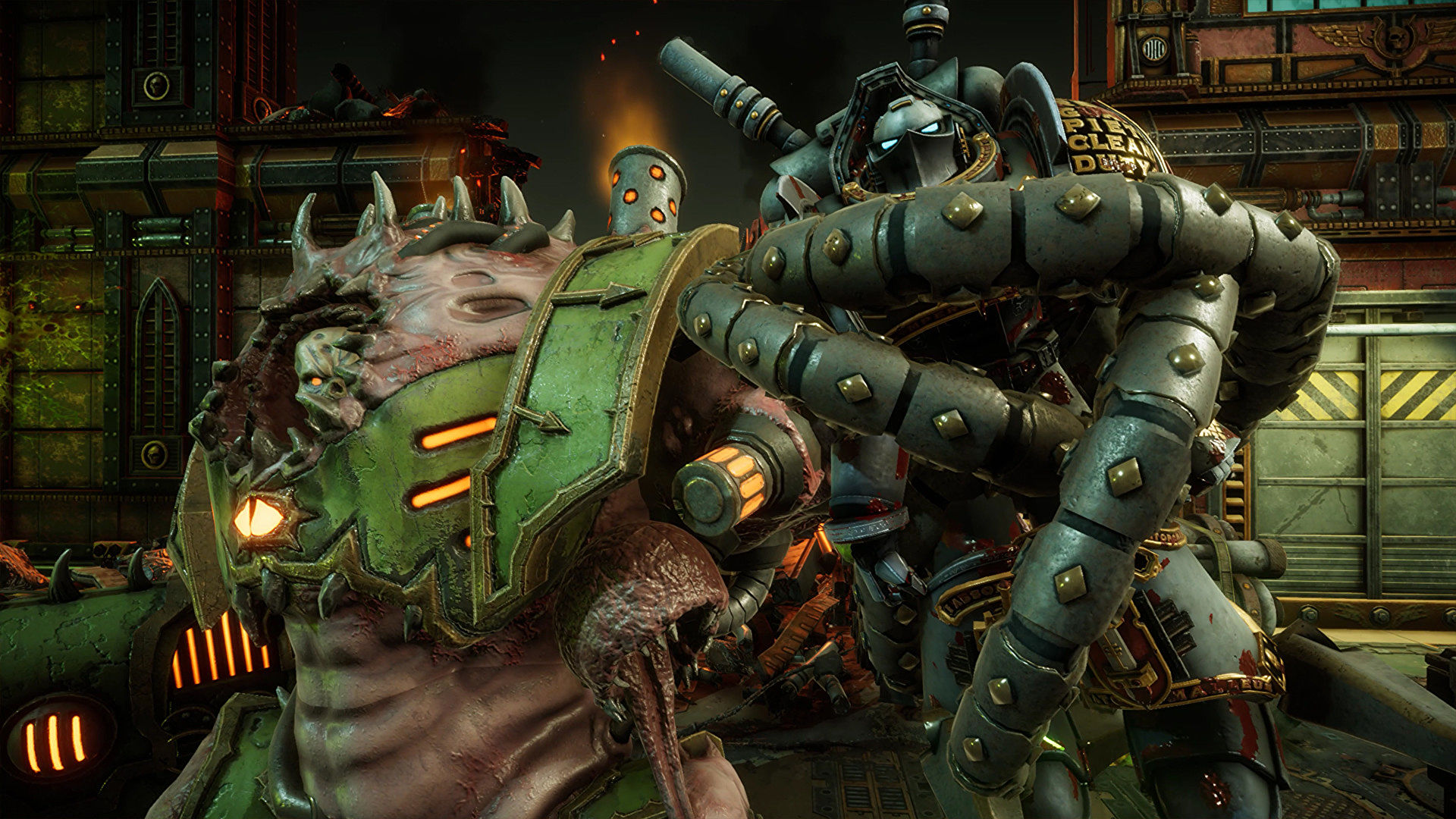When I found my party of four knights entrenched in a ditch, surrounded by literally over a dozen enemy units, I knew I was in for a rough time.
Warhammer 40K: Chaos Gate Daemonhunters is a brutally challenging strategy title, at times too much so, that takes the formula XCOM established years ago and puts a Warhammer spin. Chaos Gate sees you taking control of an Imperium ship called the Baleful Edict, commanding squads of knights to combat the forces of Nurgle and a deadly plague known as “The Bloom”.
Chaos Gate’s story starts out slow, but slowly builds to a crescendo that loops in some surprising twists and turns. The narrative does a good job of explaining everything and keeping things self-contained, but knowledge of Warhammer 40K will definitely go a long way toward immersing you in the universe.
The biggest problem I have with the narrative is how it gets bogged down by generic missions. Most of your time with Chaos Gate is spent playing through generic missions that have you simply taking out swathes of enemies. It’s interesting when the story moves along, but a lot of the 40 to 50 hour playtime feels padded.
If you’ve played an XCOM-style game before, you’ll immediately be familiar with the general setup and flow of Chaos Gate. Missions take place on massive top-down maps, with your team and the enemy taking turns.
You can take up to four knights into each mission, and knights can fall into a variety of different classes, like the healing-focused Apothecaries or squad leader Justicars. On top of this, you can outfit your knights with ranged and melee weapons, different armor, tools, and more. Knights also level up through combat, letting you unlock new and useful abilities.
During battle each of your knights has a set amount of willpower that can be spent to use powerful abilities. Of course, there are also the typical features of any XCOM-like, such as taking cover, setting up overwatch, various combat effects like being pinned, and more. The good news is that your knights are incredibly mobile, able to bound over gaps and climb walls with ease.
You have plenty of options in combat, but Chaos Gate loves to throw an ungodly amount of enemies at you in each mission. There are squads and objectives scattered around each map, but where the trouble really comes in is with a system known as Warp Surge.
At the top of the screen is a gauge that raises each time you or an enemy uses an ability, and once the gauge is full a random effect that either hurts you or benefits your enemy will happen.
The Warp Surge’s effects can include things like enemy reinforcements warping in, enemy soldiers getting powerful mutations or a section of the map becoming poisonous. Warp Surge can create some serious danger, bringing your mission that’s going well to a screeching halt.
Chaos Gate walks a fine line between being challenging and being utterly frustrating, and there were often moments that I couldn’t help but feel the game was being downright unfair. Multiple missions ended up with my party of four facing down literally over a dozen enemies, with overwatches covering almost every conceivable area of movement.
While I didn’t run into too many, Chaos Gate also has its fair share of bugs. Visual glitches and slowdown are prone to happen, and your shots can sometimes be blocked by objects even if the forecast gives you a 100 percent hit chance. There’s nothing game-breaking, but the bugs can be a minor annoyance.
The first 5 to 8 hours of the game are absolutely brutal, but the good news is that Chaos Gate does a good job of incrementally introducing improvements and new options.
When you aren’t playing through a mission, you’ll spend the majority of your time onboard the Baleful Edict, traveling between systems to stop the Bloom.
The game runs on a day system, and as time passes Bloom plagues pop up on the various planets on the system map. Your goal is to put down these plagues and control the spread throughout the system, and each plague spot represents a new mission that’s on a timer. At first, you won’t be able to hit every planet in time.
You have two major options for improving your forces while days pass: constructing improvements onboard your ship and conducting research. The various facilities you build have a variety of effects, like boosting your knights’ XP or unlocking a Stasis Chamber that lets you store and use dead knights.
Research, on the other hand, is used to improve the battle capabilities of your knights and unlock Strategems that are used during combat. Research, and eventually upgrading weapons, requires Bloom Seeds, which can only be gained during combat, by killing seed carriers with a critical hit.
Again, in the first few hours, you’ll have a horrible time collecting a lot of seeds, but the game introduces a wealth of new options as you progress.
On top of all these options, every 60 days of in-game time you’ll have to file a report to the Grandmaster. This presents you with dialogue choices that can lead to specific benefits, if you choose the right thing. If you make the wrong choices, however, you might get some kind of handicap like reduced research speed.
As you might have gathered, Chaos Gate has a lot of moving pieces that you’ll need to learn, but they’re wisely sprinkled in across the experience incrementally instead of being dropped in your lap all at once. It helps create a nice sense of advancement, even as the walls of the plague close in around you.
The core gameplay of Chaos Gate is backed up by a strong visual style that leans heavily into the grittiness of Warhammer 40K.
Grenades can cause massive explosions that send debris flying in every direction, and enemies fall apart in a shower of blood and limbs as your knights hack them apart. Chaos Gate’s developer, Complex Games, definitely knows how to nail the visual style and feel of Warhammer.
Warhammer 40K: Chaos Gate Daemonhunters — The Bottom Line
Pros
- Deep customization systems that are introduced at a good pace.
- Strong narrative with a few interesting twists.
- Great visual style that takes advantage of Warhammer.
Cons
- Overwhelming difficulty that can easily be off-putting in early hours.
- While the main story is interesting, it can feel a bit too padded.
- A few bugs that still need ironing out.
While Chaos Gate has a lot of interesting systems and a strong core gameplay loop, its intense difficulty is sure to turn a lot of people off. There were a handful of times I simply had to stop playing because of how frustrating against me the odds felt. Still, there’s a strong strategy title underneath it all if you have the patience.
[Note: Frontier Foundry provided the copy of Warhammer 40K: Chaos Gate Daemonhunters used for this review.]












Published: May 17, 2022 11:37 pm